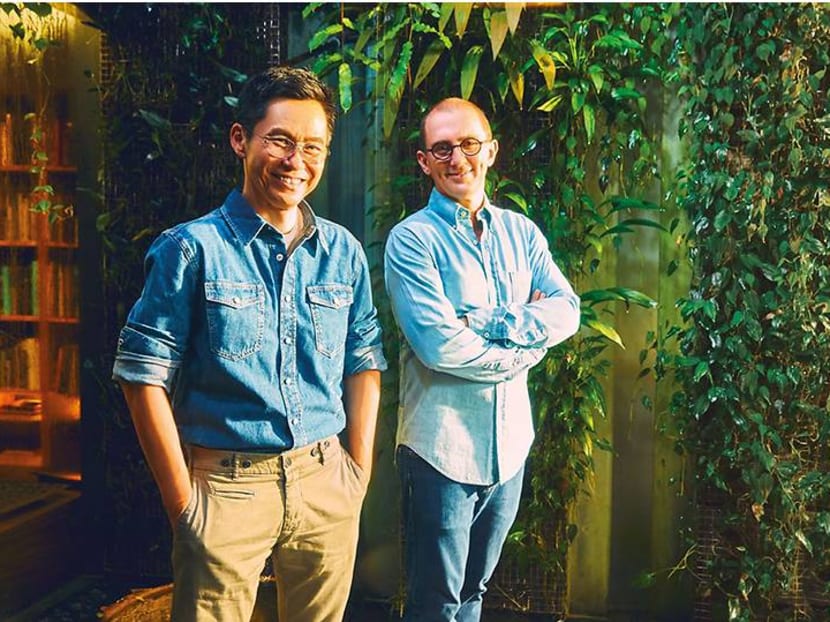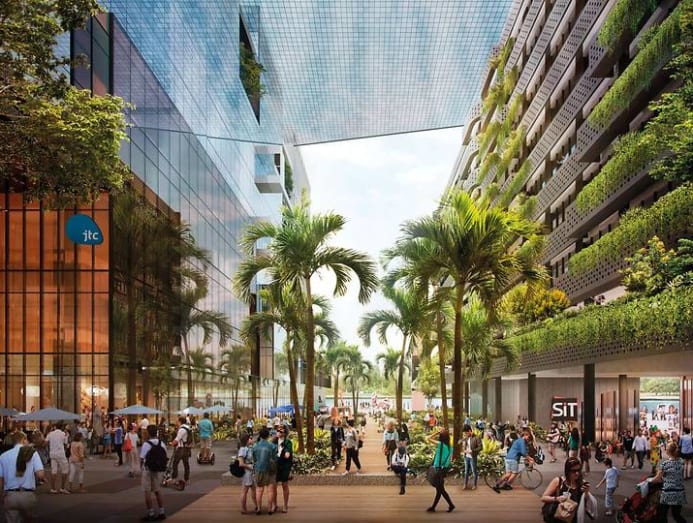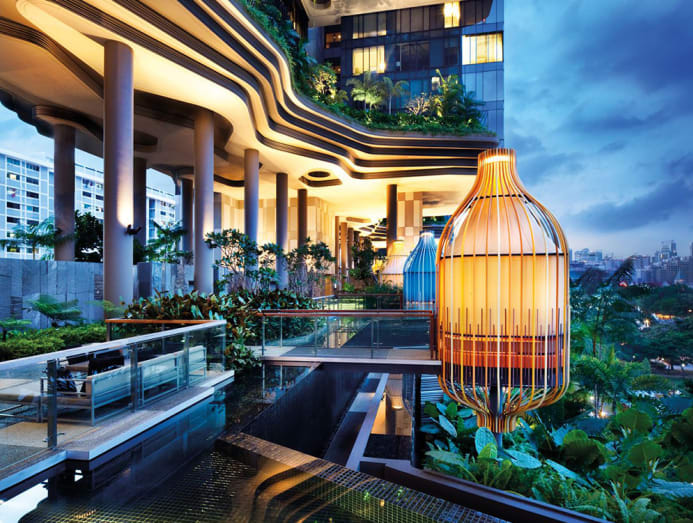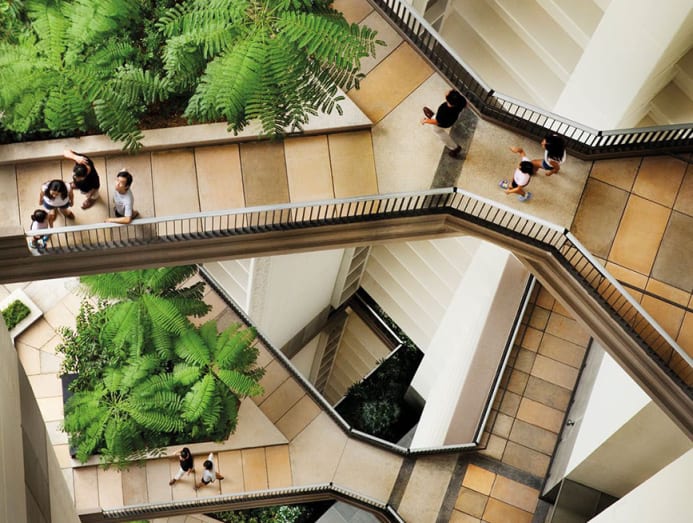The architects designing the Punggol Digital District on creating a greener Singapore
Advert
Obsessions
The architects designing the Punggol Digital Commune on creating a greener Singapore
The founding directors of WOHA Architects, Wong Mun Summ and Richard Hassell – who designed the Circle Line'due south Stadium and Bras Basah stations, and who are at present working on the principal plan for the Punggol Digital District – share their vision for creating vibrant and sustainable Asian cities.

The founding directors of WOHA Architects, Wong Mun Summ and Richard Hassell. (Photo: Singapore Tatler)
19 Jun 2022 06:30AM (Updated: fifteen Nov 2022 06:07PM)
What will the time to come look similar? "Bract Runner in the torrid zone," said Wong Mun Summ. "Blade Runner meets Avatar," added Richard Hassell. The two founding directors of compages firm WOHA have a knack for finishing each other's sentences and, in this case, they are drawing on 2 iconic scientific discipline fiction films to describe a specific swathe of Singapore's time to come – the Punggol Digital District, a 50ha development whose construction started this yr, and is slated to open progressively from 2023.
WOHA designed the master program for the commune, which volition house the Singapore Constitute of Technology'south new campus, a concern park past developer JTC, as well as community amenities. Touted every bit an innovative hub for alluring tech talent and catalysing interactions and collaborations that may just help to supercharge Singapore's economical growth, the project will also exist a large-calibration embodiment of the core principles that WOHA has been refining for decades.
SINGAPORE TATLER> How Toyo Ito designs compages that'southward fabricated for life, including this building in Singapore

"A lot of the discussion about architecture in the last 20 years has been most aesthetics. And aesthetics are of import," said Hassell. "But when you approach compages from a systems bespeak of view, you develop an mental attitude that looks across creating a standard podium and tower, so cladding that with an interesting design. We are basically maxim that every construction nosotros make is interacting with all the other systems in a city and the natural world. And we have to really call up almost how it tin can perform at a very high level in relation to these systems."

GREEN SPACES
How will these ideas manifest in a district rather than a building? For starters, "a large clamper of mature woods in the Punggol Digital District will be preserved", said Hassell. "A biodiversity study has been done that shows information technology already has lots of animals living in it, and so it will be an active and various wood, not a dry out recreated 1. People should be able to stroll through a nice shady environment." Indeed, there will exist an accent on creating pedestrian-friendly, people-centric spaces, "which volition make this place feel very unlike", said Wong.

Information technology's no surprise that the founders of a firm that's go famous for buildings lined, draped and topped with lush foliage would revel in the presence of organic nature in a place whose raison d'etre is homo-made technology. Addressing what they have described as the social dysfunction of densely packed, nonetheless increasingly isolating modern metropolises is also a long-continuing WOHA preoccupation. But make no mistake: The futurity – in Punggol anyway – may draw on deep-rooted ideas most natural and communal vitality, just cut-edge engineering science will also assistance to make information technology hum. Think underground networks traversed by autonomous vehicles delivering goods, rooftop solar ability systems soaking upward the lord's day, and sensors that tin can analyse the very air we breathe.
Imagine, in other words, if we thought about an urbanised surroundings not every bit a collection of self-contained inert structures, but every bit an ecosystem in its original sense – a community of organisms whose interactions are fundamental to collective survival. What if the Garden Metropolis didn't simply look light-green, simply was reframed in terms of cultivating resilience?
"We tin can no longer call up in a very elementary way where one land parcel is merely for one use," Wong stressed.
Hassell elaborated: "Our architecture prototypes have prepare new directions in showing how systems thinking works. We're hoping to test these ideas in this sizeable district to show they work, and curl them out at an fifty-fifty larger calibration in the hereafter."

AT THE START
Of course, the reason the Garden City, or any city for that affair, would demand to recall about condign self-sufficient in the get-go place is because of the spectre of climate change. Increasingly frequent farthermost weather phenomena in recent years have pushed the issue more insistently into the public consciousness, and things could well get worse – a lot worse.
"I don't recollect we're going to see a gradual decline. What I think is more likely is that there will be a tipping point, where suddenly 1 collapse triggers another," said Hassell.
"The earth is a complex system. Nosotros take interrupted the arrangement, and information technology'due south hard to predict where it's going to go."
If, for instance, the planet tin no longer sustain nutrient production, a place such as Singapore that imports the majority of its nutrient supplies volition become exceedingly vulnerable. "Every country would say nosotros demand our nutrient for our own people, nosotros don't care how much you lot pay united states. There could be wars over water, mass migration to escape the damage of climate change – the touch on could be really terrifying. People should be a lot more than worried than they are right now, enough to commit real resource and strategies to solving the problem."

"I'thou a picayune more positive," said Wong. "The technology that tin help is out there." What'southward needed, he believes, is bottom-upward advocacy by denizens and some long-term planning from governments. "There accept been enough wake-upward calls already, everyone is aware of the problem. We all need to save the world."
The seeds for their earth view were planted in their youth. Hassell was very much influenced past his father, who has a PhD in geology and was very alee of his time in terms of his ecology interests. The air conditioning in the elder Hassell's part was solar-powered, and he even built a null-free energy country house.
Hassell and Wong became architecture students in the 1980s, the erstwhile at the University of Western Australia and the latter at the National University of Singapore. Declining petroleum supply and escalating fuel prices in the 1970s had spurred an interest in alternative free energy, and both men call back existence exposed to ideas well-nigh sustainability in environmental science classes. Another prevailing idea at the time was regionalism, Wong recalls, which examined compages's relationship to specific climates and cultures.
But past the time they met in 1990, while working at Kerry Hill Architects, the fuel crisis had passed and an era of conspicuous consumption was well on its mode. The starchitect syndrome, where brand names created buildings with unique forms, dominated the field.
The challenge of creating architecture that addressed climatic change was "a problem that we didn't know the solution to", added Hassell. "From a design, research and innovation bespeak of view, that was actually very exciting."
Information technology took them a while to become going. After several years of designing resorts at Kerry Hill, they struck out on their own with WOHA in 1994. "We felt the most urgent sustainability problems were happening in cities, and doing beautiful resorts in remote locations felt a bit similar the orchestra playing on the deck of the Titanic while information technology was sinking," said Hassell. Or, equally Wong put it: "We wanted to get real."
SINGAPORE TATLER> 10 eco-conscious lighting pieces for your home

THE Cracking EXPERIMENT
They started by designing houses, experimenting with strategies in natural ventilation and permeable pattern that tempered the touch of intense equatorial heat and lashing monsoon rains, while not sealing these habitations off from their climatic environments. This laid a foundation for what Wong calls a "contemporary tropical linguistic communication". In 2000, they resolved to try for larger public projects and entered a contest to pattern two MRT stations. Their winning entries would eventually be realised equally the Circle Line's Stadium and Bras Basah stations.
In 2001, they entered another contest, this time to design Duxton Plain, a public housing evolution. They didn't win that one, but it was nevertheless a seminal experience. "Nosotros proposed ideas that may have been likewise ahead of their fourth dimension," said Wong. But the ideas left an impression on the authorities, and their time would come.
For instance, in its Duxton Plain design, WOHA had proposed loftier-rise buildings punctuated by interconnected "sky streets" and "heaven villages", which would not merely be spaces for placing greenery that could contribute to biodiversity, just also recreate the social vibrancy of street‑level interactions. In 2007, this concept was refined for SkyVille@Dawson, and finally realised when that public housing development was completed in 2015. Said Wong: "Those ideas – thinking of a building as a 3-dimensional matrix in the sky with streets, villages and facilities all outdoors and up high– are still being used in our projects."
DESIGNING FOR OUR ELDERLY
Take Kampung Admiralty, an 11-storey pioneering retirement village that integrates public housing for the elderly with healthcare and wellness facilities, as well as a childcare middle, eateries, retail stores and a rooftop community farm. Opened in 2017, it has won numerous awards, including Earth Building of the Yr at the prestigious World Architecture Festival in 2018.
"Information technology's been designed with a lot of intendance, and it'south a very robust edifice," said Hassell. Besides sustainable systems for filtering water and capturing solar energy, "what I think is the well-nigh interesting thing about Kampung Admiralty is the juxtaposition of the various facilities and uses", said Wong. "For case, the elderly residents can savor a communal 'sky park' nigh their homes, but they can also easily access the busy plaza on the ground floor and all the amenities. There are a fair number of seniors in wheelchairs, but you'll also find young families. It'southward a not bad mix, and it doesn't feel similar a facility for the elderly."
At the time of the design competition for this development in 2013, he remembers, at that place had been some public contention over the idea of building retirement homes in regular neighbourhoods – otherwise known as the "not in my lawn" (or "Nimby") syndrome. "We felt it was so important for us to demonstrate how it could be done well."

"Oftentimes, architecture is like a prison for them," Hassell explained. "It isolates them and makes it difficult for them to come up out." By designing for a diversity of users and creating opportunities for them to interact, "we've immune for different systems to interplay". And a more complex and intertwined ecosystem, perhaps, may well yield more than fruitful connections – another grade of resilience.
This well-received development could show influential for subsequent eldercare projects not just in Singapore, merely abroad. There has been a lot of interest from China, Australia and Europe in replicating the concept, "but the weather condition need to be right before a project like this tin can take place", Wong cautioned. Where a small metropolis-state like Singapore tin be more effective at getting many authorities agencies to work together, that may not exist the case in larger and more complex contexts. "If the design parameters and laws are unlike, are you prepared to modify them if you want something like this? Helping them to examine their policies is where we can starting time to make a divergence."
LOOKING Forward
Ask them what project they would like to tackle next, and Wong goes for a literal moonshot. "Maybe terraforming some place in outer infinite?" he mused wryly. "We may eventually need to live in a self-contained system outside earth." While this planet still spins, withal, they take faith that their painstakingly honed insights and skills will show useful for Asia'southward fast-growing cities. "We can work across large and small-scale scales, and that is vital," said Hassell. "If you lot only retrieve of the large scale, you can't brand environments that are humane. We are constantly reminding ourselves to recollect: What would this design feel similar for a human?"
A case in point: Visit the rooftop farm in Kampung Admiralty, and you'll find a collection of plants that will be familiar to people who still call back what it was like to live in a kampong, including buah cherry trees whose fruits village children once used every bit slingshot armament. Imagine growing old here if you used to be i of those children, a tangible connectedness to your by growing in your communal heaven garden. What does the future expect similar? If nosotros play our cards correct, it could, hopefully, look something like this – a sustained kinship with living, breathing histories.
A version of this story first appeared on Singapore Tatler .
SINGAPORE TATLER> Why famed builder Patricia Urquiola designs with a social focus
Recent Searches
Trending Topics
Source: https://cnalifestyle.channelnewsasia.com/access/woha-architects-founders-wong-mun-summ-richard-hassell-227021

0 Response to "The architects designing the Punggol Digital District on creating a greener Singapore"
Post a Comment